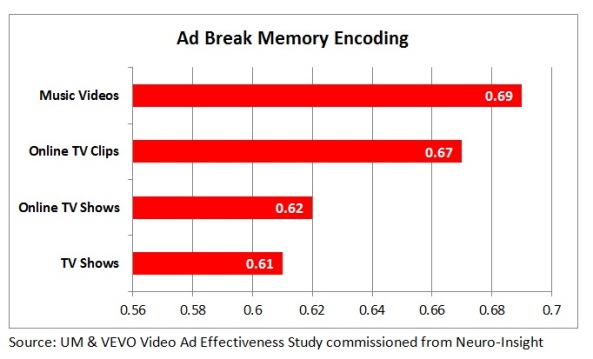New Breakthrough Evidence on Video's Ad Effectiveness by Channel - Graeme Hutton-UM

In 2007, Millward Brown undertook the first industry-wide study of consumer-controlled, ad-supported video content. Dubbed the C-TV study, it concluded that, in terms of ad recall, online video advertising was substantially more effective than TV advertising.
In 2007, Millward Brown undertook the first industry-wide study of consumer-controlled, ad-supported video content. Dubbed the C-TV study, it concluded that, in terms of ad recall, online video advertising was substantially more effective than TV advertising.
This year, in a major collaborative neuroscience study with VEVO, the prominent music-video channel, UM wanted to revisit that basic premise to probe if screen attention alone was the prime driver of this channel differential. The aim of the study was to establish video ad-effectiveness baselines by platform and, via a detailed examination of how viewers consume video, critically determine why such platform differences exist. We wanted to understand these differences for four types of video channel: TV programs, online TV programs, online TV clips and music videos.
In close partnership with VEVO, we mutually agreed that Neuro-Insight, a leading neuromarketing company, could not only provide insightful channel effectiveness benchmarks, but also perceptive diagnostics on how consumers processed the various video advertising platforms in their brains.
From my own perspective, I was eager to ascertain the power of advertising video effectiveness calibrated across three related metrics:
1. Memory encoding: This was the overarching metric to determine channel ad effectiveness.Via Neuro-Insight's innovative neurometrics, we tracked the very moment consumers memorized any advertising message element that could be later tapped by those consumers.
2. Emotional intensity. What causes consumers to subconsciously memorize a specific element of an ad? For this we used emotional intensity, which Neuro-Insight had demonstrated in earlier studies was the key spur, the gatekeeper, to memory encoding.
3. Content engagement: A neuroscience metric of personal relevance and immersion in the editorial content – a measure of attention plus involvement.
While we found that content engagement was higher for online TV programs compared to the equivalent, conventional TV show, this wasn't the case for emotional intensity where the difference was only slight. Across all four platforms, the winner for emotional intensity was music videos. This makes great sense: After all, who doesn't like watching their favorite music video, whether it's Michael Jackson's Thriller or Lady Gaga's Bad Romance? Even Snowball, the parrot, has been known to dance to Queen's Another One Bites The Dust as anyone can see here.
From the study, we witnessed how emotional intensity has a powerful impact on a channel's potential ad effectiveness. In summary, our results for the critical measure of memory encoding were as follows:

What transformed this study into an exciting set of insights was the second-by-second detail Neuro-Insight was able to furnish for each client's ad we submitted. This indicated that each ad worked differently by platform. Overall, to maximize the ad power of each platform, I would interpret our findings from this – and earlier UM cross-platform studies – as follows:
Television: Harness its lean-back characteristics – tell a 30-second story or anecdote that builds over that time.
Online TV: Capitalize on online's higher attention levels – use shorter time-lengths, which allow more immediate, early-on detail.
Music Video: Leverage in a similar approach to online TV – but actively make more use of music in the ad's sound track and exploit the viewer's emotional immersion that music videos can provide.
This study implies that while online video advertising is generally more effective than television advertising, it is too simplistic to regard that as a definitive distinction. The role of each platform is more nuanced, and its power can vary with the creative message, for better or for worse. Marketers, agencies and their media partners need to work in partnership to a much greater extent, as in this study, to maximize the impact of a message on each platform and to understand fundamentally how to enhance their channel messaging for the future.
Graeme is SVP, Director of Consumer Insights & Research, Graeme is responsible for ensuring that all appropriate proprietary and syndicated research tools and resources are applied in the development of consumer insight strategies, for a total communications research platform--from TV to chat rooms--which informs the efforts of Universal McCann and its agency partners. Graeme can be reached at Graeme.hutton@umww.com
Read all Graeme's MediaBizBloggers commentaries at Curious Thoughts from Curious Minds.
Check us out on Facebook at MediaBizBloggers.com
Follow our Twitter updates @MediaBizBlogger
The opinions and points of view expressed in this commentary are exclusively the views of the author and do not necessarily represent the views of MediaBizBloggers.com management or associated bloggers. MediaBizBloggers is an open thought leadership platform and readers may share their comments and opinions in response to all commentaries.


